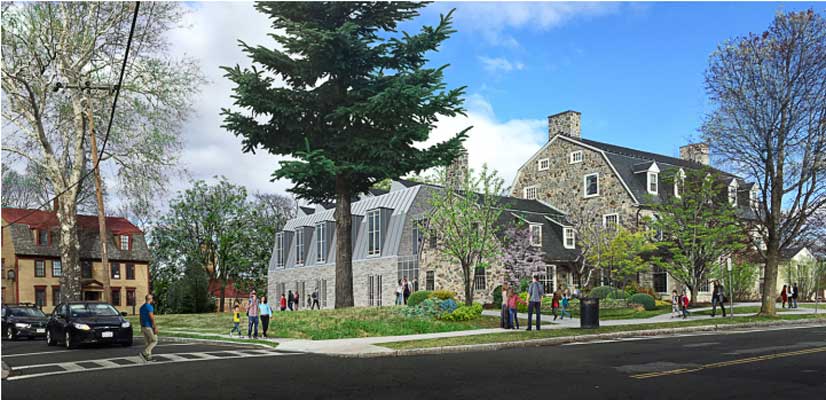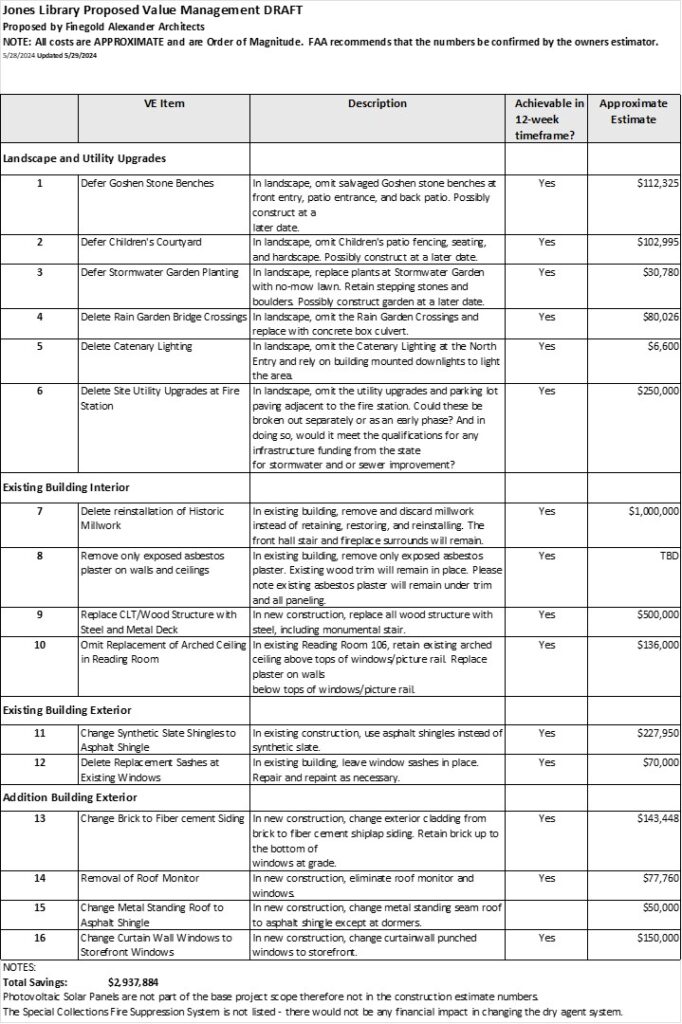Building Committee Approves Deep Cuts to Library Design

Photo: https://www.joneslibrary.org/
Climate Friendliness and Historic Preservation Features Chopped
The Jones Library Building Committee (JLBC) met on June 4, 2024 to consider a list of design changes recommended by Finegold Alexander Architects (FAA) to make construction documents more attractive to contractors when town leaders plan to re-bid the renovation-expansion project in September. In April an initial invitation of bids for constructing the $46.1 million project attracted only one response which was $7 million over budget.
The list of 16 “value management” changes was approved unanimously and en masse by the JLBC, with the added stipulation that Change #11, change synthetic slate shingles to asphalt shingles, be augmented with an alternative bid for continuing with an artificial slate roof to conform with the historic building’s natural slate roof which planners intend to replace.
Facilities Supervisor George Hicks-Richards was concerned about the use of asphalt shingles and warned that this could lead the Amherst Historic Commission to delay the project for non-compliance with the library’s historic preservation restrictions. Library Director Sharon Sharry asked if the Historical Commission would be swayed by the lower cost of the project and offer a waiver. She received no answer.

In addition to suspending or cutting back on several landscaping and utility upgrades, the heart of the design’s sustainability and historic preservation goals are being abandoned.
See related Designers Propose Cuts to Library Sustainability and Historic Preservation
Holding up a study by Western Builders (WB) from January 2017 JLBC project promoters argued that addressing deferred maintenance and urgent repairs will cost the town more than adding a 15,000 sq. ft. addition, demolishing a 30-year-old addition, gutting the nationally recognized historic 1928 building and tossing out several key climate friendly initiatives.
Often lost in the noise is the fact that the Western Builders study and subsequent revision by Kuhn Riddle Architects (KRA) is based on both problematic parts of the building, such as an aging HVAC system, and improvements to the library desired by the director and trustees. It would be understandable if library leaders, in striving to receive the greatest amount of funding from the Town of Amherst and the Massachusetts Board of Library Commissioners (MBLC), might describe a wish list rather than a minimal cost scenario to Western Builders. The Town of Amherst has never sought an independent analysis or planned for limited repairs if funding for renovation-expansion is insufficient.
JLBC members expressed a consensus that bringing the project under budget was worth the loss in value of the project resulting from the 16 cuts.
Town Manager Paul Bockelman expressed satisfaction with the value management proposals. Bockelman has the authority to expend town funds to keep the project moving forward, despite a recommendation from six of thirteen town councilors to halt the project a night earlier. Should the MBLC approve an extension to a June 30 deadline to start construction, Bockelman has indicated his intention to sign a redesign contract with FAA by June 10.
See related Council Narrowly Defeats Move to End Jones Library Expansion Project
FAA has estimated value management redesign could cost the town $800,000. Project management would add another $11,000 per month according to OPM Tim Alix of Colliers. Alix has also said that inflation could be expected to add $800,000 to $1.2 million to project cost in six months.
JLBC Chair Austin Sarat offered members of the public two minutes each to comment. No meeting packet had been provided at meeting time, leaving members of the public unaware of the full content of the value management list being deliberated. Bockelman requested that the list be shared on the Zoom session. Sharry joked, “now you’re just talking crazy talk, Paul,” but eventually succeeded in displaying the value management spreadsheet on the screen.
Public Comment
Town Councilor Cathy Schoen (District 1) commented that donors have contributed money to the Library Capital Campaign based on its improved sustainability promises and wondered if the proposed cuts such as the loss of cross-laminated timber construction, might jeopardize these pledges. She described “value management” as a misnomer. “You are taking value out of the project,” she said. She also pointed out that using asphalt instead of synthetic slate shingles, and replacing brick with fiber cement would require more frequent maintenance and be an additional expense to the town.
Schoen advised the JLBC to go out to bid without the drastic feature cuts.
Friends of the Jones Library Treasurer Nat Larson asked the committee not to let the perfect be the enemy of the good, and advised the JLBC to stay the course.
Hilda Greenbaum, whose personal donation financed the renovation and expansion of the historic North Amherst branch library, said, “I can’t believe what I’m hearing. The Jones Library has been my living room for 70 years now. It is heartbreaking to me that you would even consider removing all that beautiful woodwork. It was made from Philippine mahogany and Philippine walnut by hands that can no longer do that kind of carving.”
She concluded, “I know that if you do the right project and make it affordable to people, then money, including from myself, would become available. … I think the right thing to do is to leave the historic building alone and repair and restore when necessary.”
Jones Library Capital Campaign Co-chair Kent Faerber referred to the WB/KRA improvement study, arguing that the items being cut will not show up in “the more expensive alternative” (i.e. the repair only option). “This option [re-bidding renovation-expansion] will turn out to be the least expensive alternative available to the town,” he said.

I disagree with the contention that Paul Bockelman “has the authority to expend town funds to keep the project moving forward.”
I do not believe Bockelman has the authority to sign a redesign contract with FAA. He has no funding source. He even stated that on Monday at the Town Council meeting: “We can’t move forward unless we have a contract that’s funded. So until there’s a funding source to pay for that contract, if it’s $300,000 or $800,000, we can’t move forward.”
A September 2022 MOA amendment granted him the authority to expend $1.8 million more to get the project to bidding ($400,000 had been spent up to Sept 2022, for an estimated total of $2.2m to get to bidding). We know from public records requests that the $1.8m since Sept 2022 has already been exceeded. In fact, they have paid more than $2.3m for the project to date. Less than $600,000 remains in the MBLC grant account at this time, and that is before paying invoices for work done in April and May. Even if Bockelman had the authority — and he does not — there isn’t enough money left in that account to pay the redesign costs.
Bockelman does not have the authority to negotiate and sign a new MOA either without getting the approval of Town Council. The fact that he did not discuss what would be in a new MOA on Monday is totally unacceptable. The Trustees discussed it at their meeting on Thursday June 6 and have a motion to approve a new MOA on their June 10 agenda.
The Town Manager is not protecting the Town from further expense and liability.
I can hardly believe what I’m reading in the list of items to be removed from the expansion project. That the project was supposed to be a green improvement was a core argument for it, constantly harped up by its supporters. Preserving the beautiful woodwork was another significant argument, as well as a promise to retain other historic elements of the building, such as slate roofing and the wooden staircase. This is becoming a truly scorched earth project, with proponents clutching at straws to move it forward. The continued insistence that repair is a costlier alternative, comparing the most expensive version of repair with the cheapest version of expansion, is becoming increasingly unhinged. My question, which has not yet been answered, is what is behind the obsessive drive behind this drive. Given all the very significant needs of the town and the continuous reduction in the bang we get for the buck, why are some so insistent on spending millions on this unnecessary addition to a building the town doesn’t even own?
This article also misses the fact that asphalt has a much shorter life expectancy, 15 years or at most 30 compared to 50 to 100 for the slate . This means no longer make sense to add solar later because it has a longer life expectancy than the proposed cheap roofing material. Another cut is to delete upgrading utility lines, water and sewer in the back toward the fire station. The suggestion during the meeting was the town can do this later. This may be counter to planning board and permits that make such investment a requirement with major demolition and expansion projects.
It also shifts necessary cost to the town.
Notably, not replacing single paned glass with double paned glass will increase electricity costs.
There was no discussion about the integrity of the building nor shift or cuts that shifted costs to later Town taxpayer budgets
Short lived roofs, exteriors changes that requiring painting and higher utility costs will mean higher operating and repair costs.
All very short sighted. For $46 million or more we should expect a building with materials that last for very long time and address climate change.
The Town/Library Trustees have no legal authority to “remove and discard [historic] millwork” in the 1928 Jones Library building.
This qualifies as an “adverse effect” to a property on the State and National Registers of Historic Places. By applying for the MBLC construction grant, Town Manager Paul Bockelman legally obligated the Town/Trustees to notify the Massachusetts Historical Commission of this intended “adverse effect.”
Bockelman further obligated the Town/Trustees to participate, in good faith, in the Commission’s mandatory consultation process to eliminate, minimize, or mitigate this and all the other “adverse effects” of this project.
Surely Mr. Bockelman wants the Town/Trustees to comply with the applicable law, and to compete the undoubtedly necessary redesign before sending this benighted project out, yet again, for bid.
Ms Sharry announced that the library is no longer depending on historical tax credits. And to answer Mr. Conover: it’s pure EGO.
They, the supporters, are so involved , they and the director, can’t conceive of a possible middle ground.
In the end a net saving under $2,000,000 is “bobkes” (Austin will understand) compared to the long term cost and regrets from having lost a precious historical resource and the environmental costs to the taxpayer and the planet.
Surely a thoughtful attorney can establish sufficient grounds to enjoin Town and Library officials from executing a potentially unlawful contract in Superior Court.
Rob,
Past history seems to indicate that Hampshire Superior Court rules for The Town rather than aggrieved parties. Also KPLaw is paid to defend The Town’s interest not the appellant. What is a solution?